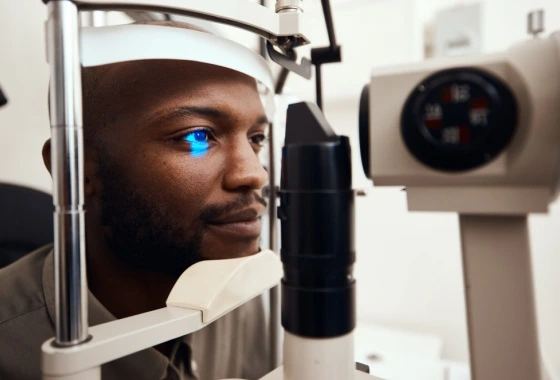
Refractive Lens Exchange (RLE)
At Cincinnati Eye Institute, we believe it’s crucial that we offer our patients from the Cincinnati area and Northern Kentucky a full range of vision correction procedures so they can select the option that best fits their needs. One option that is ideal for many of our patients who are over the age of 40 and experiencing near vision loss is refractive lens exchange.
- What is Refractive Lens Exchange (RLE)?
- What Can Refractive Lens Exchange Treat?
- Benefits of Refractive Lens Exchange
- Who Is a Candidate for Refractive Lens Exchange?
- Intraocular Lens (IOL) Options
- Preparing for RLE
- The Refractive Lens Exchange Procedure
- Refractive Lens Exchange Recovery and Results
- Frequently Asked Questions About Refractive Lens Exchange

What is Refractive Lens Exchange (RLE)?
Refractive lens exchange, or RLE, may also be referred to as clear lens extraction or clear lens exchange. This vision correction procedure is designed to reduce the need for glasses and/or contacts by removing the eye’s natural lens and replacing it with a customized artificial intraocular lens implant (IOL).
The RLE procedure is identical to the procedure for cataract surgery, except that it is an elective procedure performed to reduce the need for eyeglasses and contact lenses. Refractive lens exchange is an ideal option for patients who require bifocals to see at multiple distances or for patients who see well at distance, but require reading glasses for near tasks ( a condition called “presbyopia”). While LASIK or PRK can correct one’s distance vision, an RLE can correct both one’s distance vision AND near vision!

What Can Refractive Lens Exchange Treat?
Refractive lens exchange is an ideal treatment for presbyopia, or age-related loss of near vision. As we age, the eye’s natural lens loses elasticity, which can make tasks such as reading or cell phone use more difficult.Unlike other refractive errors that are related to the shape of the eye, presbyopia is an acquired refractive error that affects everybody beginning in their 40s. This is the reason that many people begin to wear reading glasses, bifocals, or progressive lenses as they reach
Trusted Source
What is Presbyopia?
American Academy of Ophthalmology
Go to Source
middle age.
In addition to treating presbyopia, our doctors can also perform refractive lens exchange to treat farsightedness (hyperopia) and astigmatism.
Benefits of Refractive Lens Exchange
Refractive lens exchange is an ideal option for many of our patients who desire to reduce or eliminate their dependence on eyeglasses or contacts. Some of the many benefits of RLE include:
- Improvement of presbyopia as well as astigmatism and nearsightedness
- Improved vision at multiple ranges
- The procedure is fast and comfortable with a short recovery period
- RLE may be an option for patients who are not candidates for other refractive surgery procedures
- Because the lens of the eye is replaced during RLE, patients who undergo this procedure will not require cataract surgery in the future
Who Is a Candidate for Refractive Lens Exchange?
The ideal candidate for refractive lens exchange:
- Is over the age of 40
- Has been diagnosed with presbyopia
- Has refractive errors that aren’t well-treated by laser vision correction surgery
- Desires less dependence on glasses and contacts
Some patients who may not be good candidates for LASIK may be great candidates for Refractive Lens Exchange.
Intraocular Lens (IOL) Options
By offering a full range of IOL options, our eye surgeons are able to customize vision correction during refractive lens exchange.
Presbyopia-Correcting IOLs
We offer a number of IOL options designed to correct presbyopia, including extended-depth-of-focus (EDOF) IOLs and multifocal IOLs, making it possible to correct vision at multiple distances.
Astigmatism-Correcting IOLs
Toric IOls are designed specifically for patients who have astigmatism, and can help astigmatic patients see more clearly at multiple different ranges.
Monovision with Standard IOLs
Monovision involves implanting one single-focusIOL designed to improve near or intermediate vision and another to improve distance vision. The brain combines images from each eye, resulting in clearer vision at multiple ranges.
Preparing for RLE
There isn’t much you need to do to prepare for refractive lens exchange. During your vision correction consultation at Cincinnati Eye Institute, you will undergo a brief eye exam before discussing your vision correction options with your eye surgeon. If you are a good candidate for RLE, your procedure will be scheduled. At that time, we will give you detailed pre- and postoperative instructions.

The Refractive Lens Exchange Procedure
Refractive lens exchange is performed as an outpatient surgical procedure in a sterile operative room for optimal safety.
The procedure is performed on one eye at a time and usually takes only 10-15 minutes to complete. Before beginning the procedure, your eye surgeon will apply anesthetic eye drops to numb your eyes and you will be offered an oral sedative to help you relax. A device will be used to hold your eyes open so you won’t need to worry about blinking.
Two microscopic incisions are created to remove the natural lens of the eye which is then replaced with your customized intraocular lens implant (IOL). The incisions used for refractive lens exchange are so small that no sutures or glues are typically needed.

Refractive Lens Exchange Recovery and Results
For the first few days after your refractive lens exchange procedure, you will need to wear a protective eye shield when sleeping. It is common for patients to experience blurry vision, mild discomfort, and/or itchy eyes at first as the eye is recovering from surgery. Please don’t rub or touch your eyes!
Your eye doctor will prescribe anti-inflammatory and antibiotic eye drops, and you should closely follow their instructions for administering these drops.
Our patients need very little downtime after RLE: most get back to work and other regular activities within 24 to 48 hours.
One of the best things about refractive lens exchange is how quickly our patients notice results. You’ll begin to notice clearer vision within days, and within a few weeks you’ll realize the full results of your vision correction procedure.

Frequently Asked Questions About Refractive Lens Exchange
Is refractive lens exchange covered by insurance?
Refractive lens exchange is an elective procedure, so it is not covered by insurance. We believe that each patient deserves clear vision regardless of their budgets, so we offer a number of payment and financing options.
How much does refractive lens exchange cost?
The cost of refractive lens exchange depends on the type of IOL used to correct the patient’s refractive errors. During your RLE consultation, we will give you a detailed cost breakdown for your treatment plan.
What are the risks of refractive lens exchange?
Refractive Lens exchange is exceptionally safe, with risks identical to those of cataract surgery. The American Academy of Ophthalmology reports that
Trusted Source
Cataract Surgery
American Academy of Ophthalmology
Go to Source
refractive lens exchange risks
are rare and could include:
- Infection
- Inflammation
- IOL dislocation
- Retinal detachment
How is refractive lens exchange different from LASIK?
LASIK is a laser vision correction that changes the shape of the cornea to correct refractive errors, but leaves the lens of the eye unaltered. This means that presbyopia is not treated with LASIK. Because refractive lens exchange involves replacing the natural lens of the eye with an IOL, this is an ideal treatment for patients with age-related near vision loss.
Contact Us
If you live in the Cincinnati area or in Northern Kentucky and would like to learn more about customized vision correction with refractive lens exchange, please contact us for a consultation.
1 American Academy of Ophthalmology. What is Presbyopia? Available: https://www.aao.org/eye-health/diseases/what-is-presbyopia. Accessed January 30, 2023.
2 American Academy of Ophthalmology. Cataract Surgery. Available: https://www.aao.org/eye-health/diseases/what-is-cataract-surgery. Accessed January 30, 2023.
The doctors at Cincinnati Eye Institute have either authored or reviewed the content on this site.





